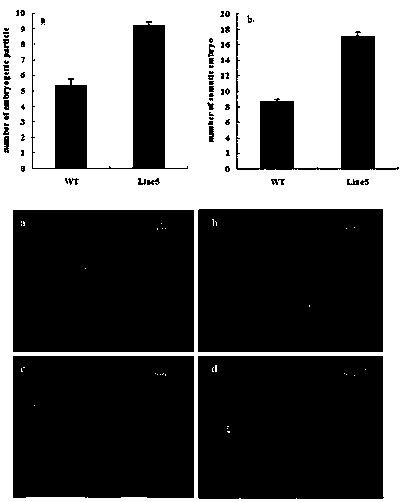Method for genetic transformation of pineapple somatic embryogenic receptor kinase gene AcSERK1 and application thereof
A genetic transformation method and receptor-like kinase technology, applied in biochemical equipment and methods, applications, horticultural methods, etc., can solve the problem of low genetic transformation efficiency, few and long gene function research reports, and it takes at least 7 months To achieve the effects of improving the efficiency of genetic transformation, promoting the occurrence of somatic embryos, and promoting the formation of pineapple embryogenic cells
- Summary
- Abstract
- Description
- Claims
- Application Information
AI Technical Summary
Problems solved by technology
Method used
Image
Examples
Embodiment
[0026] Embodiment adopts the following steps to realize pineapple somatic embryogenesis receptor kinase gene AcSERK1 genetic transformation of
[0027] 1. Construction basis of plant sense expression vector pFGC5941-35s-AcSERK1 AcSERK1 cDNA (GeneBank accession number: HM236375) sequence, designed with Nco I and Xba Gene-specific primers for I restriction sites (see Table 2) to contain AcSERK1 The full-length pMD19-T of the cDNA was used as a template, and the amplification contained AcSERK1 The target fragment of the ORF, and the PCR product was recovered with the Takara recovery kit. use Nco I and Xba I Simultaneously carry out double enzyme digestion on the recovered PCR product and pFGC-5941, recover them separately, perform ligation, transformation, and bacterial liquid PCR detection (see Table 2 for carrier-specific primers), positive clones are sent to Shanghai Sangong for sequencing and identification, and no migration Code mutation to obtain a recombin...
Embodiment 2
[0040] Example 2 Application of AcSERK1 gene: The following steps were used to verify the effect of the transfer of AcSERK1 gene on pineapple somatic embryogenesis.
[0041] 1. Molecular detection of transgenic plants PCR detection method: extract genomic DNA from leaves of transformed plants, DNA from leaves of non-transformed plants (wild type) is a negative control, pFGC5941- AcSERK1 Plasmid DNA was used as a positive control, and the primers were bar gene primers (see Table 2) and vector-specific primers (see Table 2). Prepare PCR amplification reaction solution (25 μL system): 10×PCR Buffer (Mg 2+ ) 2.5 μL, dNTP (2.5mM) 2 μL, P1 (2.5mM) 1 μL, P2 (2.5mM) 1 μL, Taq Enzyme 0.2 μL, Template DNA 1 μL, ddH 2 O was added to 25 μL. The reaction conditions were: pre-denaturation at 94°C for 5 min; 30 cycles of denaturation at 94°C for 30 s, annealing at 58°C for 30 s, extension at 72°C for 1 min, and extension at 72°C for 10 min. PCR amplification products were detected by ...
PUM
 Login to View More
Login to View More Abstract
Description
Claims
Application Information
 Login to View More
Login to View More - R&D
- Intellectual Property
- Life Sciences
- Materials
- Tech Scout
- Unparalleled Data Quality
- Higher Quality Content
- 60% Fewer Hallucinations
Browse by: Latest US Patents, China's latest patents, Technical Efficacy Thesaurus, Application Domain, Technology Topic, Popular Technical Reports.
© 2025 PatSnap. All rights reserved.Legal|Privacy policy|Modern Slavery Act Transparency Statement|Sitemap|About US| Contact US: help@patsnap.com



